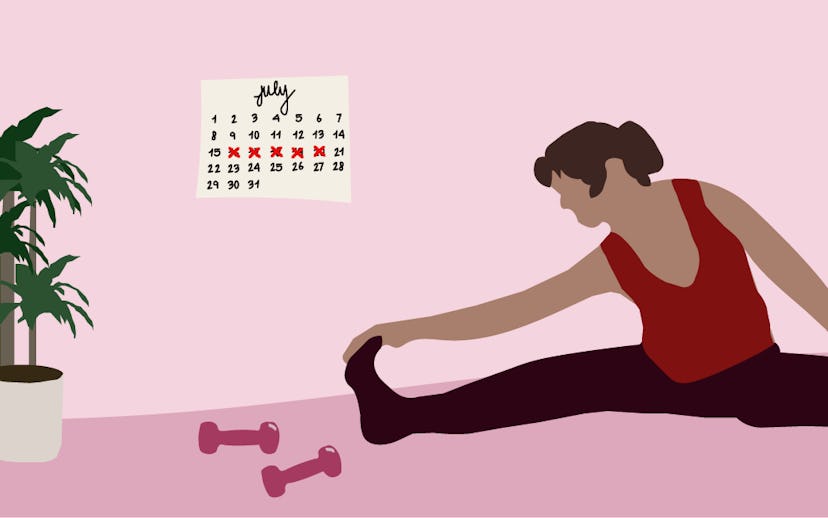
How Your Period Affects Your Exercise Schedule—And What To Do About It
How to make your period work for you
It’s tempting to hide under the covers and binge on Netflix when your PMS or a particularly heavy period strikes. For many women, our hormonal fluctuations last throughout the month, not just when we’re actually menstruating, and this can make for some up-and-down workout results and body feels. The good news is that exercise can help. The bad news is that, to make it work for you, you need to be a bit of a body detective. So when should you just chill in the AC at home? When should you use those hormones to rage in a CrossFit session? And when should you cry it out in restorative yoga?
The first step: get to know your cycle. "Keep a journal. These days my clients are all about tracking every little move,” says women’s health and athlete expert Dr. Stacy Sims. "They have activity trackers and sleep monitors and apps that help them analyze every morsel they put into their mouths. Yet I’m surprised how few women make note of their menstrual cycle and how they feel during it.”
She recommends using an app or just making a few notes in your calendar, marking not just when you’re bleeding but when you’re experiencing PMS symptoms and how you feel after certain workouts.
Then, look for patterns. While there are some general rules of what each part of your cycle will do to your body, we all react differently to the flood of hormones that sweeps through our bodies throughout the cycle—and a cycle is rarely the perfect 28 days, so knowing how often you’re actually starting a new cycle can be great intel.
"As you train through several cycles, pay attention to how your body reacts and responds to training during each phase,” Sims adds. "It’ll help you identify when you’re strongest and when you need to put in a little extra work for the performance you want."
Once you have that under control, it’s time to look at the stages of our cycles, and what makes the most sense from a workout perspective during each one.
During PMS
Yeah, it’s the worst and you might not want to get to the gym. But a 2013 study showed that women who engaged in aerobic activity actually lessened their symptoms of PMS, from bloating to headaches to cramping. Even if you’re feeling too crappy to hit that CrossFit class, swap the weight-lifting for a gentler form of cardio, like a brisk walk or chill jog. The movement can help keep your gut moving along, which might aid in decreasing that bloat and help you avoid the water retention that’s typical during this time.
You may need to slow your roll though—studies have shown that your reaction to heat during this phase may be less than optimal since your core temperature may be a bit elevated, so try to get your cardio in in shady areas or an air-conditioned gym, and make sure to re-hydrate after training!
Pro Tip: Right before your period, you may experience some gut distress, so if you know you tend to deal with diarrhea right before and during your cycle, plan a run route with restrooms in mind!
During Your Period
The weird but good news: Your performance doesn’t actually suffer when you’re on your period. Let’s be honest, part of that might be because you’re angry at the world and feel the need to rage, making those CrossFit Workouts of the Day super-intense. That’s great, go with that feeling.
In ROAR: How to Match Your Food and Fitness to Your Unique Female Physiology for Optimum Performance, Great Health, and a Strong, Lean Body for Life by Sims, she recommends supplementing with branched-chain amino acids (especially leucine) during your period. You’ll skip the feelings of fatigue and that general funky brain fog feeling, she explains.
Pro Tip: Do what feels right for you, and try to be in touch with your body during your period, really letting yourself listen to what it needs. Alyssa Vitti, the author of WomanCode: Perfect Your Cycle, Amplify Your Fertility, Supercharge Your Sex Drive, and Become a Power Source, notes that this part of your cycle is when you’re most primed for self-analysis and course correction, so if you’re really feeling SoulCycle versus a boot camp class, grab those spin shoes and have fun.
After Your Period
You’re now in the follicular and ovulatory phases, which last about two weeks. You’ll likely be feeling more energized and revitalized, so this is a great time for those group workouts and trying new classes at the gym. If you are trying to drop a few pounds for health reasons, this is also going to be the easiest time of the month to eat cleaner and lighter, as you won’t be feeling quite as many cravings.
Pro tip: This is your energy high point for the month, so make the most of it. That might mean planning your hardest workouts for this week or even hopping into a 5K on these weekends.
What About Birth Control?
Bad news: Unless you’re using a non-hormonal form of birth control, your hormones aren’t going to be working exactly as your body prefers. That doesn’t mean they aren’t still working for you, just that things like your progesterone will be higher throughout the month versus ebbing and flowing. So expect to feel less of the effects of each cycle if you’re relying on a hormonal birth control.
Pro tip: If you don’t feel like your birth control is working for you—if you’re experiencing worse PMS symptoms, hoping to shift to a less hormone-heavy method, or having extremely heavy flows, talk to your gynecologist sooner rather than later. It’s very possible that there’s a better method out there for you!